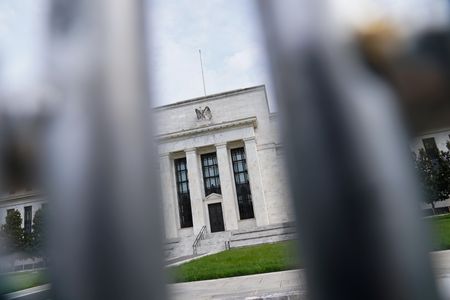By Douglas Gillison
(Reuters) -The Federal Reserve on Friday blamed the deregulatory zeal that occurred during the Trump era for contributing to the second-largest bank failure in U.S. history, appearing to take a clear stand on an acrimonious policy divide in Washington.
Amid the turmoil that Silicon Valley Bank’s implosion unleashed on the financial system last month, some Republicans and industry advocates have argued strenuously that a 2018 roll-back of post-financial-crisis safeguards was not to blame.
But the Fed’s searing 100-page post mortem says bipartisan legislation in 2018 loosened post-financial crisis safeguards, undermining oversight by hindering the work of bank supervisors and encouraging the capital weakness that ultimately proved fatal to SVB.
Greg Baer, president of the Bank Policy Institute, a lobby group, said the Fed had blamed the 2018 changes when the results of its own review showed “the fundamental misjudgments made by its examination teams.”
According to the Fed, SVB’s management bore significant blame and bank examiners also made grave missteps. The report, however, also pointed to the Fed’s vice chair for supervision at the time, without naming him, for creating what it said was a culture of weak and lax supervision that favored inaction.
Randal Quarles, who was appointed to the Fed by President Donald Trump in 2017, oversaw the Fed’s bank supervision until his resignation in 2021.
Quarles rejected the report’s findings about his work, saying it cited “no evidence at all” that Fed supervisory policy had gone astray during his tenure.
“Having acknowledged that there is no evidence, the rest of the 102-page report makes no effort to pretend to find any,” Quarles said in a statement he shared with Reuters.
The Fed did not offer any further comment on criticism of its report and actions.
Elsewhere, the report appeared only to harden long-set policy positions. Democratic Senator Elizabeth Warren, who serves on the Senate Banking Committee and has led post-crisis reforms to rein in financial sector excesses, said the report “clearly identified” 2018 legislation among the “major contributors” to SVB’s demise.
Patrick McHenry, the Republican chair of the House of Representatives Financial Services Committee, blasted the Fed report as a “thinly veiled attempt” to justify positions like those of Warren.
In 2018, a significant number of Senate Democrats joined all Republicans in rolling back key provisions of the 2010 Dodd-Frank Wall Street reforms enacted after the global financial crisis. Among other things, the new law raised the threshold at which the most intensive oversight is required to $250 billion in assets, from $50 billion, a key point cited in the report.
The reforms ultimately meant looser regulation and lower capital requirements at precisely the wrong time, according to the report.
“While higher supervisory and regulatory requirements may not have prevented the firm’s failure, they would likely have bolstered the resilience of Silicon Valley Bank,” the report said.
The collapse of SVB and Signature Bank last month burned a $23 billion hole in a government fund for deposit insurance, which officials are preparing to recoup in special fees expected to fall most heavily on the largest U.S. banks.
It was unclear on Friday whether the Fed report made it more likely lawmakers could ultimately undo 2018’s deregulation, with a narrowly divided Congress consumed by a battle over raising the government’s borrowing limit to avert a default on U.S. sovereign debt in the coming months.
According to the report, the 2018 law caused the Fed to raise the supervisory threshold for large banks, i.e. those smaller than the “global systemically important banks,” to $100 billion in assets from $50 billion – delaying stricter oversight of SVB “by at least three years.”
Had SVB been subject to the capital and liquidity requirements that existed before, the report said, SVB “may have more proactively managed its liquidity and capital positions or maintained a different balance sheet composition.”
(Reporting by Douglas Gillison, Hannah Lang, Chris Prentice and Lananh Nguyen; Editing by Megan Davies, Leslie Adler and William Mallard)

